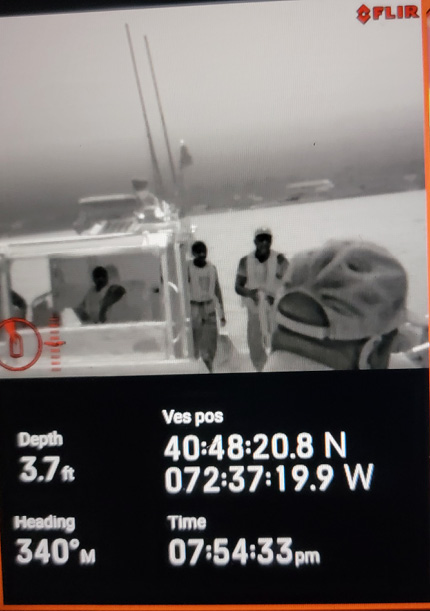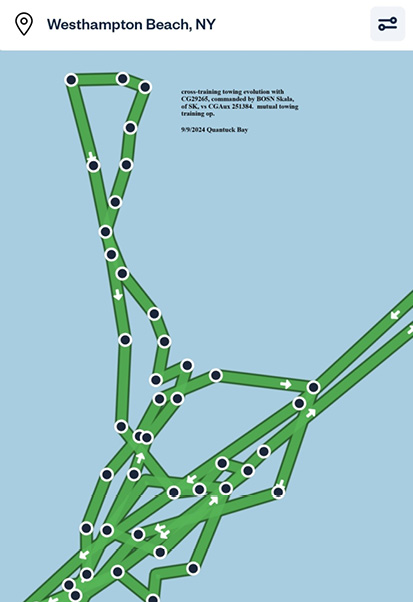Many have heard me say, and hopefully act in fidelity with, the words above. While all Coast Guard Auxiliarists have the absolute option to say, “No, sorry. I just can’t do ‘x’ for you,” the vast majority of us say, “Yes, yes and yes” when asked to undertake some task for active-duty.
You may notice that I didn’t say “the U.S. Coast Guard” because I didn’t want to subtly imply that Coast Guard Auxiliarists aren’t part of the wider enterprise. We are. Each of us – on duty or not, in uniform or not – is a walking, talking member of U.S. Coast Guard Forces. And we are compelled by all rules, instructions and guidelines that govern our behavior – including how we wear the uniform – to act that way.
Cross-Training
One of the most special requests by active-duty of we auxiliary members is to conduct cross-training with them. Not only do we get to interact, up close and personal, with members of active-duty, but we are providing an invaluable service to them – our cleats aren’t where their cleats are! When conducting towing training, when active-duty trains against themselves, everything is the same – cleat positions, freeboard height, vessel weight, vessel seaworthiness, etc. So, if they conduct 100 towing exercises, all they’ve done is “step up, step down, step up, step down” without really making any progress. So, when confronted with a real Search and Rescue (SAR) case, there’s no muscle memory to rely upon – everything must be analyzed and reacted to anew – which takes time, which is never an ally in an SAR case.
So, conducting cross-training with auxiliary boats – what are called an “Operational Facility” (OPFAC) in the language of our Service – is a real benefit and thus a real privilege to be asked of us. Fall happens to be the best season for cross-training simply because there’s less boating traffic for the U.S. Coast Guard to have to respond to. Once Labor Day comes, a lot of boaters start to put their boats “up on the hard” and start to dream about the Spring. That opens windows for cross-training and that means us.
September 9, 2024
On the night of 9/9, in 20 knot winds, the crew of OPFAC #251384 was tasked with cross-training with USCG #29266 – with BOSN Christopher Skala, Officer in Charge of Station Shinnecock, in command of the active-duty vessel. We met in Quantuck Bay, around low tide to add to the challenge. And crab pots were also out there. So, strong winds, low tide, total darkness, crab pots and senior active-duty member at hand – no pressure, shipmates!

Crewman Andrew Tarantino drew the short straw, going up to the bow in total darkness to catch a towline from an active-duty USCG vessel.
The crew – comprised of Jamie Bedell, Flotilla Commander/18-06, Andrew Tarantino, Vice-Flotilla Commander/18-06, FSO-Member Training/18-06 Paul Meszik, and me at the helm – set out to be both a good target for active-duty but also to show active-duty that we were competent enough to be relied upon for SAR cases when they were too over-tasked to respond themselves.
First, active-duty took us into a “stern tow” – they ran their towing tackle from their stern to our bow. That meant that one of us had to go the bow and catch the line being thrown from #29266. In the dark. In wind. With active-duty watching…All went well, as Andrew caught the line, efficiently attached their towing bridle to our fore cleats and returned to the cockpit.
Next, active-duty took us into a “side tow,” placing #251384 on their “hip,” a necessary step before preparing to take a towed vessel and lay them up alongside a dock for repairs. Afterwards, under similar conditions, the crew of #251384 took #29266 into an identical side tow, dispensing with the stern tow action and going directly to the more challenging task. Thirty or forty minutes later, we finished our cross-training exercise and made way east to the Quogue Bridge to check the lights and complete that tasking as part of the newly revitalized Bridge Inspection System.
Not to waste the unique opportunity to further train at night, #251384 also conducted a “Victor Sierra” (VS – A Vector Search pattern) SAR exercise further west in Moriches Bay, south of Buoy 33. In the dark. In the wind. No crab pots, though! Such training activity is an essential part of maintaining our “night SAR” qualifications.

A plot of the cross-training exercises
All in all, we performed to “Coast Guard standards,” earning Bravo-Zeroes (BZ – Well Done!) from BOSN Skala and maintaining our sharpness and “quals.” And, having proven our bona fides, active-duty extended our season into October so we could continue our cross-training with active-duty.
Service is indeed a rare and precious privilege. ■
If you are interested in being part of USCG Forces, email me at JoinUSCGAux@aol.com or go directly to the U.S. Coast Guard Auxiliary “Flotilla Finder” at cgaux.org/units.php and we will help you “get in this thing . . .”
The Captain of the Port and Sector Commander for U.S. Coast Guard Sector Long Island Sound is Captain Elisa Garrity. CAPT Garrity is responsible for all active-duty, reservist, civilian and auxiliary Coast Guard personnel within the Sector. As a Commodore in the U.S. Coast Guard Auxiliary First District, Southern Region, Vin Pica works closely with CAPT Garrity and her staff to promote boating safety in the waters between Connecticut, Long Island and 200 nautical miles offshore. Sector Long Island Sound Command Center can be reached 24 hours a day at 203-468-4401.
Editor’s note: Weekly updates for the waters from Eastport, ME to Shrewsbury, NJ including discrepancies in Aids to Navigation, chart corrections and waterway projects are listed in the USCG Local Notice to Mariners. Log onto navcen.uscg.gov, scroll to “Current Operational/Safety Information,” click on “Local Notice to Mariners” then “LNMs by CG District,” and click on “First District.”




